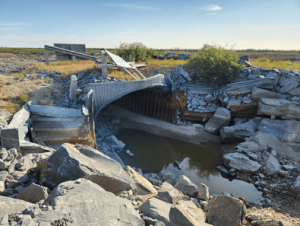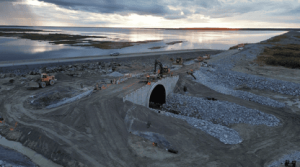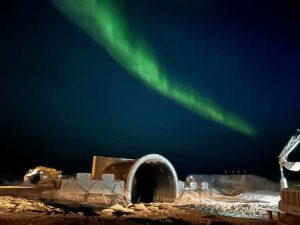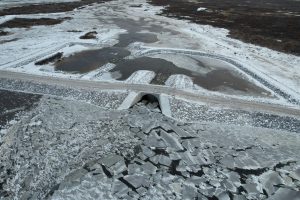By: Atlantic Industries Limited

A Testament to Resilience: Building a Resilient Fish Passage Structure in a Frozen Frontier
This unique engineering endeavor involved the installation of a new Super Cor DCSP system. This system featured a substantial corrugation profile of approximately 15 inches by 5.5 inches. The necessity for this replacement arose after a particularly severe winter compromised the integrity of the original structure. As a result, it could no longer guarantee the safe passage of fish around the dike situated on the Churchill River. The design mandate for the new structure emphasized resilience. It was important to ensure it could effectively withstand the extreme climatic conditions prevalent in the region. Moreover, this resilient fish passage structure was paramount for ecological preservation.
Overcoming Obstacles: Engineering a Robust Resilient Fish Passage Structure

The primary design challenge stemmed from the previous structure’s vulnerability to ice floe damage. Therefore, the overarching objective was to design and supply a significantly more resilient fish passage structure. It needed to be capable of enduring the area’s formidable climatic demands.
To achieve this enhanced durability, engineers strategically implemented a cast-in-place concrete headwall at the upstream end. They further reinforced it with a steel structural plate pipe facing for supplementary protection against ice impacts. Moreover, they meticulously engineered the adjacent Mechanically Stabilized Earth (MSE) wing walls. These featured thicker panels and additional reinforcing elements, specifically intended to resist the substantial pressures exerted by ice jams.
The MSE wall system also incorporated geosynthetic reinforcing, and the team treated the DCSP structure itself with a thermoplastic polymer coating. This was a critical measure given its proximity to the saltwater of Hudson Bay and the presence of brackish water, ensuring a truly resilient fish passage structure.
Logistical Puzzles: Delivering the Resilient Fish Passage Structure to a Remote Locale

The project’s location just outside Churchill, Manitoba, near the confluence of the Churchill River and Hudson Bay, presented considerable logistical hurdles. The absence of direct road access to the construction site rendered conventional truck delivery an impossibility. Instead, the essential materials embarked on a complex journey, initially arriving in Thompson, Manitoba, before being transferred to rail cars for the final segment of their transportation. This additional handling phase inherently elevated the potential for material damage during transit. Considering the constrained construction window imposed by the arctic weather conditions and the protracted lead times associated with material shipments, a proactive decision was made to supply supplementary material. This prudent measure provided a contingency for potential replacement parts, thereby mitigating the risk of project delays due to unforeseen damages.
Triumph in the Tundra: A Durable Resilient Fish Passage Structure Achieved

Despite the significant challenges posed by the harsh climate and intricate logistical constraints, the successful installation of the new resilient fish passage structure demonstrates innovative engineering and meticulous planning. This effective solution not only directly addressed the immediate need for a more durable infrastructure but also contributed to a more streamlined and cost-effective construction process. The successful completion of this vital project ensures the continued safe passage of fish. It safeguards their natural habitat and preserves the delicate ecological balance characteristic of this unique region. This remarkable achievement earned the prestigious 2025 NCSPA Structural Plate/Buried Bridge Project of the Year award.
Related Stories
2022 Project of the Year Winner – Going Green: High Speed Railway Ecological Overpass
Resiliency
Project Spotlight: Falcon Ridge 11.5′ Fish Passage Structure